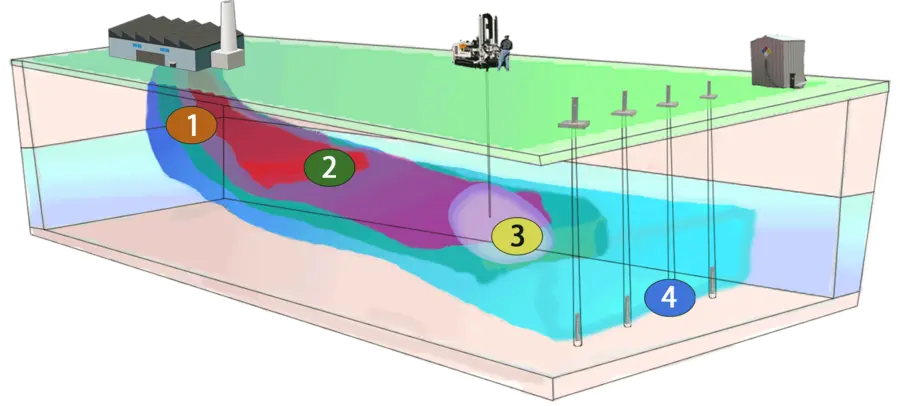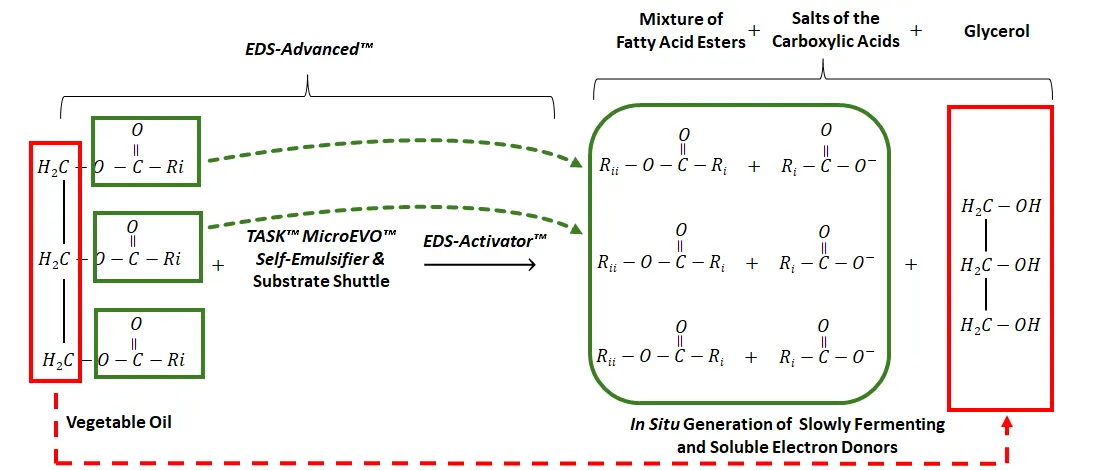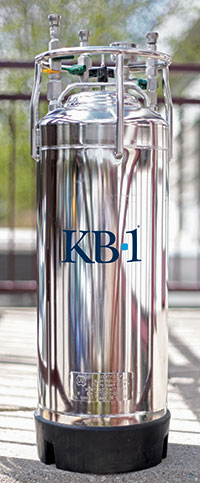Remediation Products
 Site Remediation Solutions
Site Remediation Solutions
In the realm of contaminated site remediation, a wide array of potential solutions exists. Tersus provides a versatile range of products and technologies, avoiding a singular focus on one method. Instead, Tersus tailors the right solution to meet the specific needs of your site. Our established technologies empower clients to diminish uncertainty, mitigate risks, and attain cost-effective results. Rest assured; we have comprehensive coverage for every zone of your plume!
This section highlights some of our most popular products by treatment category. Learn more about our products by selecting a treatment category. We look forward to helping you develop the optimally cost-effective, remediation approach.
- In Situ Chemical Reduction (ISCR)
In Situ Chemical Reduction (ISCR) is an innovative environmental remediation technique used to treat contaminated soil and groundwater. This approach involves introducing a reductant or reductant-generating material into the subsurface to reduce the concentrations of targeted contaminants to acceptable levels. Zero-Valent Iron (ZVI) is the most commonly used reductant for remediating chlorinated ethenes, converting them into harmless end products [1, 2], as shown in the figure below.
Abiotic and Biotic Degradation Pathways of Chlorinated Volatile Organic Compounds (CVOCs)
The reductive dechlorination of chlorinated ethenes proceeds through two major pathways: (i) Abiotic Degradation, the dominant pathway, and (ii) Biotic Degradation (hydrogenolysis), where chlorine (Cl) atoms are replaced by hydrogen atoms via biological processes [3].
ZVI promotes reductive dechlorination primarily through abiotic reactions, where iron donates electrons to chlorinated ethenes. The primary mechanism in the presence of ZVI is β-dichloroelimination, which involves the removal of two chlorine atoms from adjacent carbon atoms. This process leads to the formation of less chlorinated products, such as acetylene or other reduced compounds, potentially avoiding the production of harmful intermediates like vinyl chloride.
In the biotic pathway, sequential hydrogenolysis occurs, where enzymes facilitate the stepwise replacement of Cl atoms by hydrogen. Examples of enzymes catalyzing these reactions are provided [4, 5].
Our advanced suite of ISCR products demonstrate unparalleled efficacy in soil and groundwater remediation include:
- EDS-ZVI™: Delivered as a two-part system, EDS-ZVI™ consists of a less than 5-micron sulfidated ZVI colloidal suspension (mZVI) and a water-mixable vegetable oil-based organic substrate (EDS-ER™). This innovative product presents colloidal, sulfidated zero-valent iron particles suspended in glycerol, eliminating the necessity for on-site mixing with guar or thickening agents. Co-injecting the two-part system (mZVI and EDS-ER™) and diluting it with water results in a mixture that is easily injectable through direct push or permanent injection wells, without the mandatory requirement of pneumatic or hydraulic fracturing.
- ZVI-ironGEL™: A 45% ZVI colloidal suspension with a mean particle size of less than 10-micron, ZVI-ironGEL™ is optimized for injection at a 30 g/L ZVI concentration. The product incorporates environmentally friendly polymers engineered to create a viscoelastic gel, exhibiting shear-thinning behavior upon dilution with water. This gel ensures high colloidal stability, good injectability, and enhanced distribution in the subsurface, as showcased in our YouTube video.
- Concentrated ironGEL™ Part B: This component, identical to the concentrated gel used in ZVI-ironGEL™, is packaged separately and can create a ZVI slurry containing 45-micron ZVI at 53.1 g/L.
- ISR-Cl: A liquid iron-based reagent mirroring the natural biogeochemical reduction of solvents in aquifers. This product swiftly establishes conditions conducive to abiotic and biotic activity, facilitating the degradation of chlorinated ethenes, ethanes, and the precipitation of toxic metals. With an oxidation-reduction potential (ORP) ranging from -700 to -1,300 mV, injecting this liquid iron sulfide solution offers enhanced subsurface distribution, even in situations with lower permeability.
- ZVI Powders: Tersus offers multiple grades of highly reactive ZVI that can be specially selected to meet the varying requirements of contaminated sites.
REFERENCES
- CLU-IN, Contaminated Site Clean-Up Information, In Situ Chemical Reduction Overview https://clu-in.org/techfocus/default.focus/sec/In_Situ_Chemical_Reduction/cat/Overview/.
- Barrier P. R. 2011 Technical/Regulatory Guidance. The Interstate Technology & Regulatory Council (ITRC) PRB: Technology Update Team, Washington, DC. United States.
- Brumovský M, Tunega D. Reductive Dechlorination of Chlorinated Ethenes at the Sulfidated Zero-Valent Iron Surface: A Mechanistic DFT Study. J Phys Chem C Nanomater Interfaces. 2024 Feb 28;128(10):4180-4191. doi: 10.1021/acs.jpcc.4c00865. PMID: 38505149; PMCID: PMC10945477.
- Jugder B-E, Ertan H, Bohl S, Lee M, Marquis CP and Manefield M (2016) Organohalide Respiring Bacteria and Reductive Dehalogenases: Key Tools in Organohalide Bioremediation. Front. Microbiol. 7:249. doi: 10.3389/fmicb.2016.00249
- Wei K., Grostern A., Chan W.W.M., Richardson R.E., Edwards E.A. (2016) Electron Acceptor Interactions Between Organohalide-Respiring Bacteria: Cross-Feeding, Competition, and Inhibition. In: Adrian L., Löffler F. (eds) Organohalide-Respiring Bacteria. Springer, Berlin, Heidelberg. https://doi.org/10.1007/978-3-662-49875-0_13
-
Sakmaryova, Iva & Štrojsová, Martina & Cernik, Miroslav & Nemecek, Jan & Machackova, Jirina & Ševců, Alena. (2017). Microbial degradation of chloroethenes: a review. Environmental science and pollution research international. 24. 10.1007/s11356-017-8867-y.
- Enhanced Anaerobic Reductive Bioremediation
Anaerobic reductive bioremediation involves introducing biologically available organic amendments, known as organic substrates or electron donors, into groundwater. This process aims to create and sustain anoxic conditions by depleting oxygen through aerobic respiration, as well as other electron acceptors, during the biodegradation process. Through the fermentation reactions that generate hydrogen, anaerobic reductive bioremediation facilitates the bioreduction of oxidized contaminants, particularly chlorinated solvents. In this anaerobic environment, chlorinated compounds act as electron acceptors and undergo reductive dechlorination when paired with an electron donor [1].
Emulsified vegetable oil (EVO) slowly ferments and can act in the subsurface as an organic carbon and hydrogen source that stimulates organohalide-respiring bacteria that in turn mineralize chlorinated solvents. Indigenous microorganisms first consume and ferment EVO to generate hydrogen, fatty acids and other important nutrients and cofactors. The prevailing anaerobic conditions are ideal to reduce chlorinated solvents like TCE through dechlorination processes such as dehaloelimination. Then specialized bacteria such as Dehaloccocoides mcCartii, Dehalobacter, or Dehalogenomonas use subsurface-generated hydrogen when transforming reduced solvent to innocuous ethene.
Electron Donors for Anaerobic Reductive Bioremediation
Tersus bioremediation amendments are formulated to optimize in situ remediation of contaminated soil and groundwater. We provide:
- Emulsified Vegetable Oils (EVO): EDS-ER™, a long-lasting electron donor, revolutionized the field when released in 2011. As the first water-mixable vegetable oil-based organic substrate, it provides a sustained source of carbon and hydrogen for enhanced reductive dechlorination and other bioremediation processes. Shipped as a 100% fermentable substrate concentrate, EDS-ER™ creates optimal conditions for anaerobic remediation, consisting of refined, bleached, and deodorized soybean oil and surfactants (TASK™ MicroEVO Self-Emulsifier). When mixed with water, EDS-ER™ spontaneously transforms into an emulsified vegetable oil (EVO), see YouTube video.
- EVO Emulsifiers: TASK™ MicroEVO™ Self Emulsifier
- Soluble electron donor and nutrients:
- EDS-ME™, an EtOH/MeOH alcohol blend consisting of ethanol, methanol, and n-propyl alcohol.
- EDS-Substrate Shuttle™, a water-miscible solvent efficiently dissolves the vegetable oil, creating a solution with the distribution properties of a soluble electron donor.
- EDS-QR™
- Nutrimens® Liquid & Granular
CATALYZED Reductive Bioremediation
To optimize the distribution of fatty acids in the aquifer and to tackle the issue of biofouling, our team of surfactant specialists at Tersus has harnessed their expertise to develop EDS-Advanced™. This Catalyzed Reductive Bioremediation technology (US 11,577,231 B2 ) The procedure involves introducing a water-soluble mixture of oil (e.g., EDS-ER™) and alcohol (e.g., EDS-Substrate Shuttle™, EDS-ME™, etc. ) along with a catalyst (EDS-Activator™).
The purpose is to facilitate the following key objectives:
- The cleavage of fatty acids from the triglyceride molecule (the vetegtable oil in EDS-ER™), which then binds to the alkyl group (comprised of carbon and hydrogen) of the alcohol to produce fatty acid alkyl esters, carboxylic acids/salts, and glycerol as shown in figure below.
- Enhancing the distribution of fatty acids within the subsurface, providing aquifer buffering, and mitigating issues like biofouling and saponification.
In Situ Transesterification of Vegetable Oils
 The incorporation of the substrate shuttle into our solution marks a significant advancement in the realm of EVO injection. It leads to the creation of a solution that disperses more readily than traditional EVO in aquifers and subsurface environments through advection. The ease of distribution afforded by EDS-Advanced™ translates into greater radii of influence (ROI) achievable from a single injection point. This, in turn, reduces the number of injection points required to adequately supply a contaminated aquifer with the necessary electron donor.
The incorporation of the substrate shuttle into our solution marks a significant advancement in the realm of EVO injection. It leads to the creation of a solution that disperses more readily than traditional EVO in aquifers and subsurface environments through advection. The ease of distribution afforded by EDS-Advanced™ translates into greater radii of influence (ROI) achievable from a single injection point. This, in turn, reduces the number of injection points required to adequately supply a contaminated aquifer with the necessary electron donor.The synergy between EDS-ER™, a water-mixable vegetable oil-based organic substrate, and EDS-Activator™, a homogeneous alkaline catalyst, drives the cleavage of triglyceride molecules, resulting in the formation of fatty acid alkyl esters, carboxylic acids, and glycerol within the subsurface. These in-situ products exhibit superior mobility compared to traditional EVO, introduce a pH buffer to the system, and reduce susceptibility to clogging and biofouling. This unique combination allows for high-volume applications with fewer injection points.
Recent fieldwork conducted both in the United States and Australia has provided compelling evidence of EDS-Advanced™'s remarkable efficacy. It has demonstrated the ability to reduce up to 90% of contaminant mass within a mere 90-day post-injection, showcasing the tremendous potential of this innovative solution for subsurface remediation.
HEAT-ENHANCED CATALYZED Reductive Bioremediation
In the United States, most aquifers maintain an average temperature of approximately 15°C. Notably, organohalide-respiring bacteria thrive within a temperature range of 25 to 30°C [2]. Thermally enhanced bioremediation has been successful in combating chlorinated solvent contamination. Heat-enhanced catalyzed reductive bioremediation seamlessly combines the advantages of low-temperature in situ thermal treatment with the effectiveness of reductive bioremediation, effectively addressing challenges such as cost-efficiency in heating contaminated areas and reducing the duration of the cleanup process associated with reductive bioremediation. Our innovative approach overcomes the inherent obstacles of each method, offering a comprehensive solution for efficient and accelerated environmental remediation.
The application of heat improves the process by reducing dissolved oxygen levels in the aquifer, aiding the release of chlorinated volatile organic compounds from the matrix, and increasing the concentrations of dissolved organic carbon (electron donors). Additionally, the added heat directly stimulates dechlorinating bacteria within their optimal temperature range.
The application of heat also:
- Improves the process by reducing dissolved oxygen levels in the aquifer, aiding the release of chlorinated volatile organic compounds from the matrix, and increasing the concentrations of dissolved organic carbon (electron donors).
- Aids in the in situ transesterification of vegetable oils, enhancing the creation and distribution of slowly fermenting and water-soluble electron donors crucial for anaerobic reductive bioremediation in contaminated aquifers. This method accelerates transesterification reactions from months to mere hours by applying heat to the process. Heat not only expedites the reaction rate but also increases the yield of fatty acid alkyl esters.
Learn More
For further details or inquiries about our technologies for reductiive bioremedtaion and their applications, please do not hesitate to reach out. We are eager to discuss how this technology can address your specific needs and challenges. Contact Us
REFERENCES
- GROUNDWATER, B.O., 2013. Introduction to In Situ Bioremediation of Groundwater. 542-R-13-018 December 2013. Office of Solid Waste and Emergency Response. Preparation of this report has been funded by the U.S. Environmental Protection Agency Office of Superfund Remediation and Technology Innovation (OSRTI) under Contract Number EP-W-07-078 to Tetra Tech EM Inc.
- Löffler, F. E.; Yan, J.; Ritalahti, K. M.; Adrian, L.; Edwards, E. A.; Konstantinidis, K. T.; Müller, J.A.; Fullerton, H.; Zinder, S. H.; Spormann, A. M.,Dehalococcoides mccartyi gen. nov., sp. nov., obligately organohalide-respiring anaerobic bacteria relevant to halogen cycling and bioremediation, belong to a novel bacterial class, Dehalococcoidia classis nov., order Dehalococcoidales ord. nov. and family Dehalococcoidaceae fam. nov., within the phylum Chloroflexi. Int J Syst Evol Microbiol. 2013
- Enhanced Anaerobic Oxidative Bioremediation
Enhanced anaerobic bioremediation encompasses two main types: reductive, a well-established technology primarily utilized for treating chlorinated compounds, and oxidative, employed in the remediation of petroleum hydrocarbons.
Oxidation serves as the primary metabolic pathway for the biodegradation of petroleum hydrocarbons. This process involves the transfer of electrons from the petroleum hydrocarbon (an electron donor) to another compound known as an electron acceptor. Anaerobic oxidation occurs when compounds like sulfate act as electron acceptors. The availability of sulfate often limits the naturally occurring biodegradation of petroleum hydrocarbons. Nevertheless, it is feasible to accelerate natural biodegradation rates by supplementing additional sulfate (i.e., Nutrisulfate®) and nutrients (i.e., TersOx™ Nutrients-QR) to the subsurface microbial community.
Nutrisulfate® stimulates biodegradation by providing a high-sulfate metabolic supplement designed to enhance the kinetics and efficiency of microbial systems specifically tailored for the bioremediation of BTEX, MTBE, TBA, and other petroleum hydrocarbons. Following the revitalization of previously limited sulfate levels, anaerobic groundwater bacteria utilize petroleum hydrocarbons for carbon and energy, ultimately mineralizing the hydrocarbons into carbon dioxide and water.
Nutrisulfate® is a high sulfate metabolic supplement designed to enhance the kinetics and efficiency of microbial systems specifically related to anaerobic oxidation of BTEX, MTBE, TBA and other petroleum hydrocarbons. The increase in kinetics and efficiency decreases remediation times and reduces the amount of substrate/ amendment required.
Nutrisulfate® is suitable for easy injection and distribution. It poses no adverse effects, presenting a clean, cost-effective, and non-disruptive application for direct-push points and injection wells.
- Enhanced Aerobic Biodegradation
Enhanced aerobic biodegradation is the practice of adding oxygen to saturated soil and groundwater to encourage and sustain the growth of microorganisms required for in situ bioremediation of contaminated groundwater. It is typically used to treat low to moderate levels of contamination. Our product offerings include:
- TersOx™ Powder is a crafted calcium peroxide formulation engineered for the purpose of delivering a controlled release of molecular oxygen. Tailored to support aerobic bioremediation efforts in both soil and groundwater, TersOx™ Powder plays a pivotal role in fostering the natural degradation of hydrocarbons.
Specifically designed for the breakdown of petroleum hydrocarbons, TersOx™ Powder stands out as a catalyst for the enhancement of bioremediation processes. Unlike chemical oxidation products, TersOx™ Powder harnesses its high oxygen content, exceeding 16.6% by weight, to establish a sustained oxygen supply lasting up to 12 months under optimal conditions.
The protracted release of oxygen not only acts as a continuous energy source but also serves as a catalyst for indigenous bacteria, ultimately expediting bioactivity. This synergistic approach facilitates a more efficient and thorough removal of contaminants.
- Waterloo Emitter™ - a simple, low cost in well device designed for the controlled and uniform release of oxygen, or other bioenhancing amendments
- TersOx™ Powder is a crafted calcium peroxide formulation engineered for the purpose of delivering a controlled release of molecular oxygen. Tailored to support aerobic bioremediation efforts in both soil and groundwater, TersOx™ Powder plays a pivotal role in fostering the natural degradation of hydrocarbons.
- In Situ Chemical Oxidation (ISCO)
Tersus specializes in utilizing two main chemical oxidants: a modified Fenton’s reagent and persulfate. Through collaborative efforts with clients, Tersus offers expertise in determining the most suitable oxidant(s) for a specific site. Additionally, Tersus assists in calculating the required oxidant load and conducts Total Oxidant Demand (TOD) testing, considering dissolved contaminants, adsorbed contaminants, free-phase contaminants, dissolved and solid-phase reduced minerals, and naturally occurring organic material.
Our advanced suite of ISCO products includes:
- TersOx™ Modulator: A surfactant-based hydrogen peroxide stabilizer. Co-injected with hydrogen peroxide, it gradually generates hydroxyl free radicals, reducing oxygen demand, eliminating high contaminant inhibition, and enhancing bioremediation performance by directing biological activity towards contaminant breakdown.
- TersOx™ - NPS (Sodium Persulfate): The strongest oxidant within the peroxygen family for in situ remediation of volatile and semi-volatile organic compounds. Activating NPS with heat or a base generates sulfate radicals, highly reactive and effective in degrading organic compounds in water or soil through oxidation reactions.
- Surfactant-Enhanced Aquifer Remediation (SEAR)
Surfactant-enhanced aquifer remediation (SEAR) stands as a cost-effective alternative to traditional pump-and-treat methods for remediating aquifers tainted by non-aqueous phase organic liquids. Tersus holds the global distribution rights for the foremost surfactant technology, TASK™ (Tersus Advanced Surface Kinetics), and associated products, encompassing techniques for in situ surfactant application and chemical oxidation. Benefiting from nearly two decades of research and testing conducted at the University of Oklahoma, TASK™ Anionic Surfactant Blend presents a versatile array of applications specifically tailored to hydrocarbon contamination flushing,
- In Situ Sorption and Biodegradation
By combining powdered activated carbon with an electron acceptor to induce biodegradation, NutriBind® is meticulously formulated to address the inherent challenges in soil and groundwater remediation. Serving as a potent powdered reagent, NutriBind® rapidly reduces contaminant concentrations upon application while concurrently expediting bioremediation processes.
NutriBind® facilitates biodegradation by supplying a soluble, readily available electron acceptor. In the presence of sulfate, anaerobic groundwater bacteria can efficiently utilize BTEX, MTBE, and other petroleum hydrocarbons for carbon and energy, ultimately mineralizing these compounds into carbon dioxide and water. The addition of sulfate augments natural processes and presents a more environmentally friendly solution with a lower carbon footprint compared to conventional remediation techniques.
The metabolic supplements within NutriBind® significantly enhance the kinetics and efficiency, thereby reducing the remediation time of sulfate-reducing microbial systems associated with the biodegradation of BTEX, MTBE, TBA, and other petroleum hydrocarbons.
- Bioaugmentation Cultures, Laboratory Treatability Studies and Gene-Trac® Molecular Testing
 SiREM, a company Tersus represents, provides the tools environmental professionals need to optimize remediation of chlorinated solvents and other recalcitrant chemicals. As an industry leader, SiREM provides unparalleled technical support, combined with a unique range of products and testing services, that save clients money, increase remediation effectiveness and provide peace of mind during field implementation.
SiREM, a company Tersus represents, provides the tools environmental professionals need to optimize remediation of chlorinated solvents and other recalcitrant chemicals. As an industry leader, SiREM provides unparalleled technical support, combined with a unique range of products and testing services, that save clients money, increase remediation effectiveness and provide peace of mind during field implementation.BIOAUGMENTATION CULTURES
The complete reductive dechlorination of chlorinated ethenes yields non-toxic ethene as a final product. Absent the right bacteria, you could see an accumulation of vinyl chloride. Although not necessary at every site, Tersus recommends the use of KB-1® bioaugmentation cultures.
KB-1® and KB-1® Plus bioaugmentation cultures by SiREM have been used for over a decade to enhance bioremediation of chlorinated solvents. These cultures introduce beneficial microorganisms to contaminated sites where they are absent or at low concentrations. Bioaugmentation with KB-1® and KB-1® Plus is an effective solution to enhance remediation of a growing range of chlorinated solvents and other recalcitrant compounds.
LEARN MORE
- KB-1®/KB-1® Plus
- KB-1® Plus for remediation of low pH sites
- KB-1® Primer for preparation of anaerobic water for bioaugmentation culture injections
LABORATORY TREATABILITY STUDIES
The professionals at SiREM are experts at performing treatability studies for a wide variety of contaminants. SiREM treatability studies are designed as replicated controlled experiments that provide a high level of data integrity and interpretability.
LEARN MORE
- Laboratory Treatability Studies
- Case Study, Technology Evaluation Bench-Scale TreatabilityTechnology Evaluation Bench-Scale TreatabilityTesting for a 1,1,1-TCA/TCE Site
GENE-TRAC® MOLECULAR TESTING
Gene-Trac® testing by SiREM is used to quantify key microorganisms and to determine microbial community composition for the assessment of bioremediation potential and to monitor enhanced bioremediation performance by quantifying and characterizing microorganisms in groundwater and soil/sediment from contaminated sites.
LEARN MORE
- Gene-Trac® molecular testing
- Gene-Trac® NGS (next generation sequencing) microbial community characterization
Our skill and experience implementing in situ remediation creates high-value solutions to complex groundwater and soil contamination and related issues at a lower cost. Tersus welcomes the opportunity to provide you and your team with the tools you need to successfully plan and execute your next project.
Request a Site Evaluation
Have questions or want to explore some ideas? Contact Us to learn how we can put together a money saving program to get your project over the finish line. If you currently have a project and need a remediation solution now, request a site evaluation by supplying us with the appropriate site information at this link.
Learn More
Is one of the above technologies the right solution for your contamination concern? Find out here
